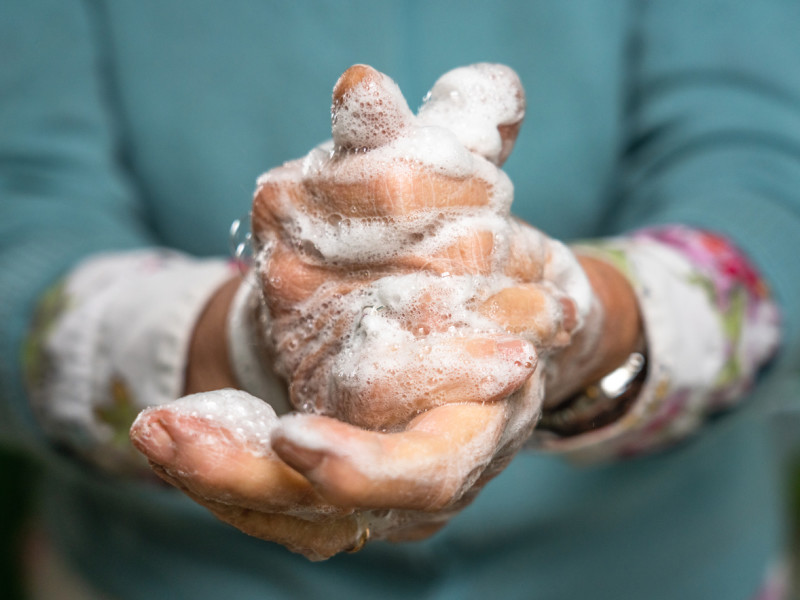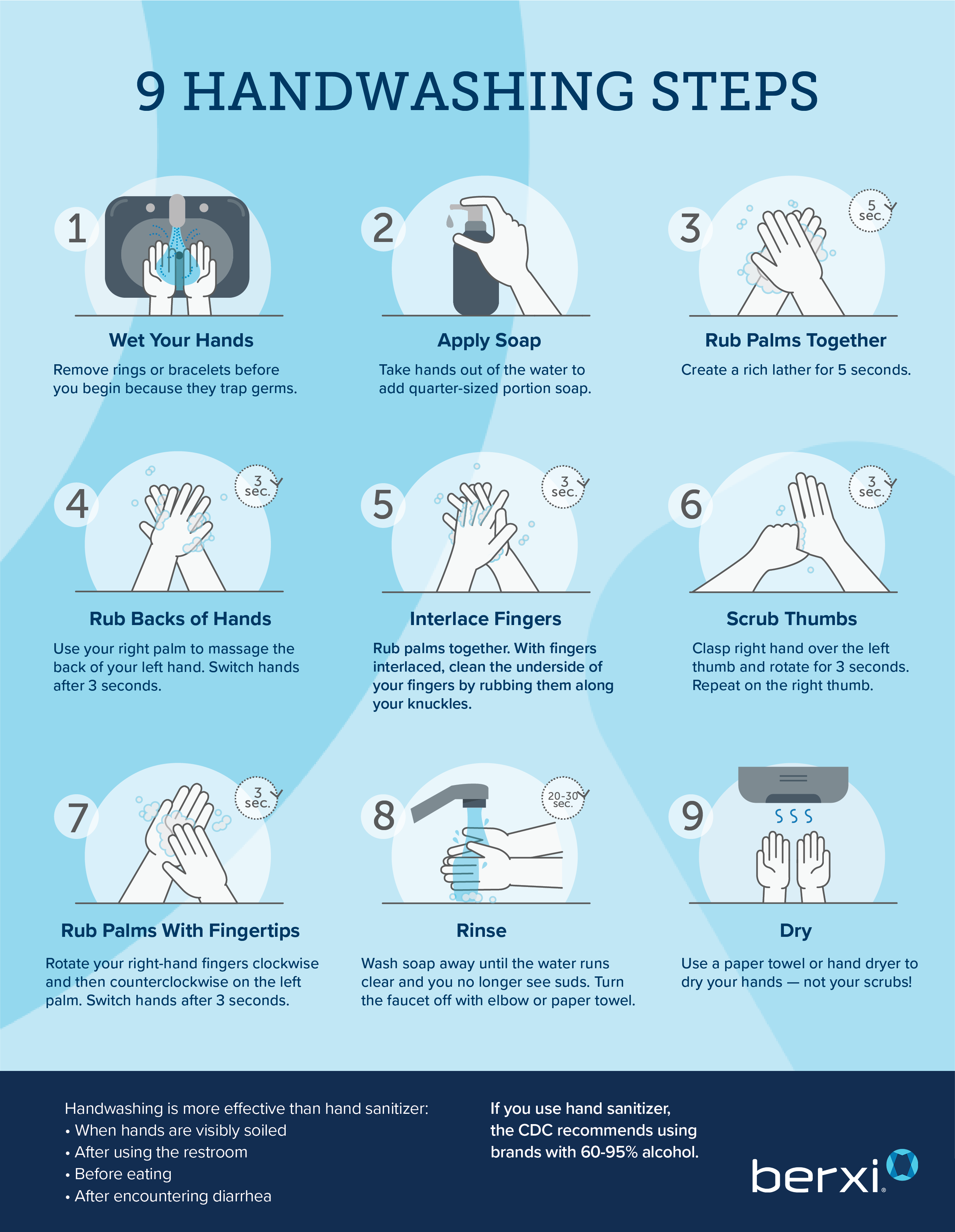
A 2020-2021 study published by the U.S. Department of Agriculture discovered that 95 percent of people don’t wash their hands properly. This is a pretty shocking discovery that should give everyone pause, especially those who care for sick patients on a regular basis like nurses.
Keep in mind, though, that there are a lot of opinions out there about the “right” way to wash your hands. In fact, a surprising amount of them either gloss over or completely skip some critical sanitizing steps in the washing process. To clear this up, we decided to find out what the World Health Organization (WHO) recommends as the proper handwashing procedure for nurses.
The following article will cover not only how to properly wash your hands but also when to wash hands vs. using hand sanitizer and how to correctly apply hand sanitizer.
Take a look at our infographic below to see a detailed outline of the WHO’s handwashing steps for nurses that they encourage everyone to follow.

And here are more detailed instructions if you’d like to learn more about each step:
Make sure that you’re using running water of at least 100 degrees Fahrenheit and that you’ve removed any jewelry (e.g., rings or bracelets) before you begin because they can trap germs.
Tip: If you’re worried about losing your rings, wear them on a chain around your neck when you’re at work, or keep them in a ring dish near the sink.
Remove your hands from the water and use a squirt of soap to remove soil and transient microorganisms from your skin.
With hands still out of the water, rub palm to palm for about five seconds to create a rich lather.
Massage the back of your left hand over your right palm for three seconds to spread the soap. Repeat the above process with your left palm on the back of your right hand.
Rub your palms over one another, this time interlacing your fingers. Keeping your fingers interlaced, run the backs of your fingers along the back of the opposing hand. Do this for three seconds.
Rub your right thumb with your left hand, clasping it tightly while rotating for three seconds. Repeat the above with your left thumb.
Using the fingers of your right hand, rub your left palm in a circling motion for three seconds, going both clockwise and counterclockwise. Repeat the above process with your left fingers and right palm.
Once you’ve been cleaning for 20 to 30 seconds, rinse the soap off your hands until the water runs clear and you don’t see suds. When you’re finished, use a paper towel to turn off the faucet. Because you’ve touched it with dirty hands, there’s a good chance that it’s harboring the bacteria and germs you just washed off.
Dry your hands with paper towels or a hand dryer rather than a cloth towel, which collects bacteria. Also, be sure not to wipe your hands on your scrubs.
While we’re focused on the proper handwashing steps for nurses to remove all germs, we shouldn’t forget about hand sanitizer.
The Centers for Disease Control and Prevention (CDC) suggests nurses use a sanitizer with at least 60% alcohol and use enough gel to cover both hands. Here’s how to use hand sanitizer correctly:
We talked to several experts at the CDC who recommend two methods to routinely clean your hands: handwashing with soap and water or hand antisepsis using an alcohol-based hand rub. Hand antisepsis is preferred in most clinical situations; however, there are times when washing your hands is a much better option.
The CDC experts list the following times anyone in (or out of) the medical profession should always wash hands:
When it comes to using hand sanitizer or washing hands, the CDC recommends nurses opt for using an alcohol-based hand sanitizers at these times:
With so much handwashing going on, you might see your hands get dry and cracked more often. The following are a few ways to keep them soft and conditioned.
It’s not news to nurses that they need to wash their hands at work. However, it might be easy to skip the 9-step, 60-second routine. Afterall, you have patients to see and not a lot of time to give. But germs are everywhere, as are risks. And both can be dangerous, and invisible.
If risk prevention is on your mind, there are more steps you can take. Consider creating a detailed risk management plan to better prevent and prepare for mishaps.
You can also explore protecting yourself with professional liability insurance. Does your workplace provide this for you? If not, you definitely need one. And if they provide basic coverage, think about getting your own additional policy. Having an individual policy can protect you in the case of a licensing board review, which employer policies often neglect. It can also allow for extra funds and additional legal support in the case of a large claim. These policies can be as low as $87 per year.
Header image courtesy of iStock.com/georgeclerk
Video courtesy of Johns Hopkins Medicine.
Last updated on Feb 14, 2025.
Originally published on Jul 02, 2018.
More:
The views expressed in this article are those of the author and do not necessarily reflect those of Berxi™ or Berkshire Hathaway Specialty Insurance Company. This article (subject to change without notice) is for informational purposes only, and does not constitute professional advice. Click here to read our full disclaimer
The product descriptions provided here are only brief summaries and may be changed without notice. The full coverage terms and details, including limitations and exclusions, are contained in the insurance policy. If you have questions about coverage available under our plans, please review the policy or contact us at 833-242-3794 or support@berxi.com. “20% savings” is based on industry pricing averages.
Berxi™ is a part of Berkshire Hathaway Specialty Insurance (BHSI). Insurance products are distributed through Berkshire Hathaway Global Insurance Services, California License # 0K09397. BHSI is part of Berkshire Hathaway’s National Indemnity group of insurance companies, consisting of National Indemnity and its affiliates, which hold financial strength ratings of A++ from AM Best and AA+ from Standard & Poor’s. The rating scales can be found at www.ambest.com and www.standardandpoors.com, respectively.
No warranty, guarantee, or representation, either expressed or implied, is made as to the correctness, accuracy, completeness, adequacy, or sufficiency of any representation or information. Any opinions expressed herein are subject to change without notice.
The information on this web site is not intended or implied to be a substitute for professional medical advice, diagnosis or treatment, and does not purport to establish a standard of care under any circumstances. All content, including text, graphics, images and information, contained on or available through this web site is for general information purposes only based upon the information available at the time of presentation, and does not constitute medical, legal, regulatory, compliance, financial, professional, or any other advice.
BHSI makes no representation and assumes no responsibility or liability for the accuracy of information contained on or available through this web site, and such information is subject to change without notice. You are encouraged to consider and confirm any information obtained from or through this web site with other sources, and review all information regarding any medical condition or treatment with your physician or medical care provider. NEVER DISREGARD PROFESSIONAL MEDICAL ADVICE OR DELAY SEEKING MEDICAL TREATMENT BECAUSE OF SOMETHING THAT YOU HAVE READ ON OR ACCESSED THROUGH THIS WEB SITE.
BHSI is not a medical organization, and does not recommend, endorse or make any representation about the efficacy, appropriateness or suitability of any specific tests, products, procedures, treatments, services, opinions, health care providers or other information contained on or available through this web site. BHSI IS NOT RESPONSIBLE FOR, AND EXPRESSLY DISCLAIMS ALL LIABILITY FOR, ANY ADVICE, COURSE OF TREATMENT, DIAGNOSIS OR ANY OTHER SERVICES OR PRODUCTS THAT YOU OBTAIN AFTER REVIEWING THIS WEB SITE.
Click to collapse disclamerWant Berxi articles delivered straight to your inbox? Sign up for our monthly newsletter below!
"*" indicates required fields